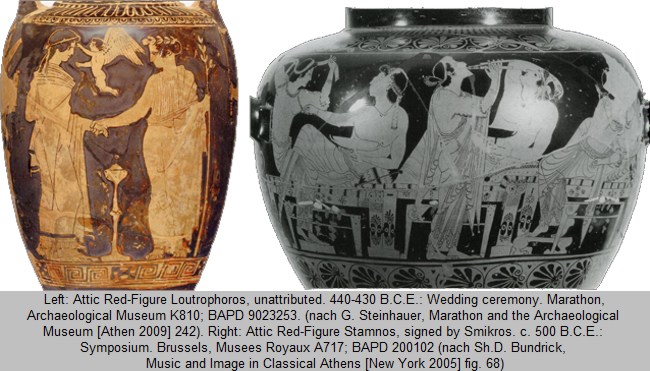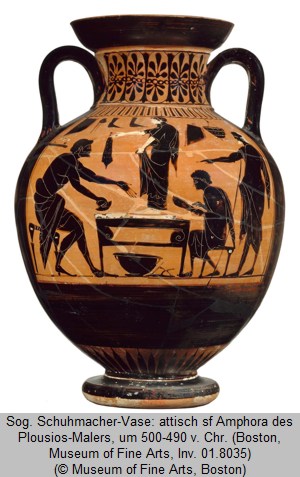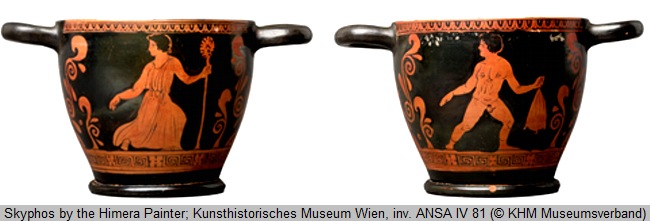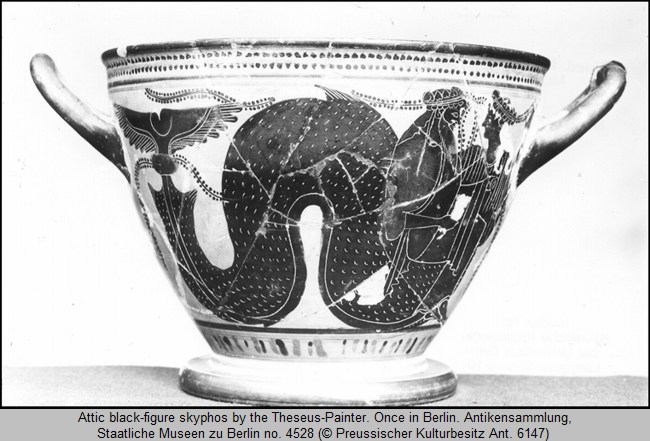
POSTER
Gendered Gazes: Targeted Communications in Attic Vase-Paintings
Danielle Bennett Smotherman (Bryn Mawr, US)
Attic vase-painters in the Archaic and Classical periods created their objects as bearers of meaning, utilizing both shape and decoration to convey cultural messages. The vases act as constructed objects of communication with targeted audiences. In this project I examine self-referential images created in Athens in the Classical period, or vase-paintings in which the imagery visually echoes the intended use-context of the shape, with respect to the intended gender of the viewer. By applying communication theory and a model of communication occurring on two axes to the study of these self-referential images, the different modes of conversation occurring within the image, the role of the viewer, and the relationship between the creator, object, and targeted audience can be explored.
The study is limited to two specific, but contrasting, cultural institutions: the symposium and the wedding. By focusing on the self-referential images of these two cultural institutions we can explore the notion of gendered communications in visual representations. Did the vase-painters use different methods of communication for male and female viewers? Are there different messages for specific audiences? Can the vase-paintings be understood on multiple levels simultaneously? In order to answer these questions, I propose that we explore the conversations within the images of multi-figure scenes and examine how male and females interact in scenes for a primarily male audience and in scenes targeted to a female audience. Visual markers, such as gestures, body language and speech inscriptions, represent both verbal and non-verbal communication in images.

While the social institutions in which the vases for men and for women were used are clearly divergent, they have a similar purpose: to reinforce cultural and social institutions, to evoke a response, and to confirm the social status of individuals. The images on the self-referential vases extend the image to the viewer and encourage the viewer to self-identify with the depicted figures. This self-identification creates a more direct connection between object and viewer as well as extending the depicted conversation to the audience. The ancient viewer could draw on his or her own life experiences to fill in details of the image. This study reveals that visual markers within self-referential images are applied differentially for these targeted audiences in Athenian society in the fifth century B.C. The variability in the application of visual markers for male and female viewers indicates the flexibility of visual conversations for both construing and visually reinforcing particular social expectations.
e-mail: dcbennett2016@gmail.com
“ὦ Ζεῦ πάτερ αἴθε πλούσιος γενοίμαν“. Zu Handelsszenen auf attischen Vasen
Heinrike Dourdoumas (Deutschlandsberg, AT)
 Nur wenige attische Gefäße mit Darstellungen von Handel oder Verkauf sind uns überliefert.
Nur wenige attische Gefäße mit Darstellungen von Handel oder Verkauf sind uns überliefert.
Im Mittelpunkt dieser Überlegungen stehen Szenen, die den Handel mit aromatisiertem Öl zeigen. Die Mehrzahl ist schwarzfigurig und stammt aus dem letzten Viertel des 6.Jhs. v.Chr., die rotfigurigen Darstellungen sind bis in die Mitte des 5.Jhs. zu datieren. Neben der Einschätzung und Beurteilung der Verkaufssituation ist besonders die Darstellung der Händler und Käufer von Interesse. Auch wird der Frage nach der Absicht der Töpfer und Vasenmaler, diese Alltagsszenen zu gestalten, nachgegangen.
e-mail: heinrike@gmx.at
Eurynome with Dionysos in the Sea. Attempts to Decipher a Mythological Episode
in Attic Art
Stamatis Fritzilas (Kalamata, GR)
Of the rich world of imagery bequeathed to us through the creations of the Greek potters of the Archaic and Classical periods, a number of Attic vases of Late Archaic date are noteworthy; specifically, a group of skyphoi from the workshop of the Theseus Painter which carry in their iconography the message of a close connection between Dionysos and the sea, and in particular between him and certain sea deities.
A fine Attic skyphos attributed to the Theseus Painter, once in Berlin, Staatl. Mus. no. 4528, preserves one of the rarest mythological episodes in ancient Greek art. Both sides of the vase were decorated with the same motif: Dionysos and a great sea-goddess in the depths of the sea. This uncommon Dionysian episode had made a brief appearance in the repertoire of Late Archaic vase-painting in the years around 500 BC. The great sea-goddess turns her head backwards while conversing with Dionysos. She wears an ivy crown round her hair aa does the god. Dionysos, holding a drinking-horn, travels seated comfortably on the back of the double-natured sea-goddess. Earlier scholarship had identified the sea-goddess next to Dionysos with some Tritoness or Nereid in general. I believe that the great maritime goddess travelling along with Dionysos is the Oceanid Eurynome; such was the original hypothesis of that profound connoisseur of Attic vase-painting, Sir J. Βeazley.
We know that this primordial goddess was half-human, half-fish, just like her father, Oceanus, who was the greatest of the Titans, son of Uranus and Gaea. The double-natured Eurynome is described as a prominent member of the first generation of gods. The iconography of the above-mentioned vases apparently depicts an episode in which Dionysos journeys to the bottom of the sea with the help of Eurynome. We know that Dionysos, when pursued across Thrace by the mythical king Lycurgus, suddenly entered Oceanus. Dionysos fled into the sea alone and sought refuge with Thetis, daughter of Nereus. According to an epic tradition, apart from the Nereid Thetis, Dionysos, who desperately seeks refuge in the sea, is also welcomed by the Oceanid Eurynome. This reference suggests the very likely possibility that what we have in the three aforementioned scenes is the descent of Dionysos into the sea. Thus, the presence of this primordial Oceanid and her salutary intervention on behalf of Dionysos could easily explain the Dionysian subject on the aforementioned skyphoi.
Therefore, the above-mentioned vase-paintings, as well as similar representations in ancient art, reinforce and illuminate the close connection between Dionysos and major sea-deities, such as the Oceanids and Nereids; this connection is known to us through various myths and cults where the god arrived from the sea. These representations also serve as iconographic complements to others which depict the triumphal advent of Dionysos by sea.
e-mail: sfritzilas@gmail.com
Kommunikation oder Repräsentation? Bilder von Berufen auf griechischen Vasen
Alice Landskron (Graz, AT)

Aus spätarchaischer und klassischer Zeit sind zahlreiche Vasenbilder erhalten, die Darstellungen von Berufen, Handwerk oder künstlerischen und landwirtschaftlichen Tätigkeiten visualisieren. In der Forschung sind für diese Arbeiten und Betätigungen Termini wie „techné“, „profession“ und „skill“ geläufig. Solche Bilder sind in verschiedenen Kontexten zu finden und kommen nicht nur in der attischen Vasenmalerei, sondern auf vielen anderen Bildträgern, etwa auf Weihtäfelchen aus Ton, auf Reliefs oder als Terrakottafigurinen vor. Zu diesen Berufsdarstellungen gehören Bilder von Handel, Bildhauerarbeiten, Szenen eines Töpferei¬betriebes, einer Schusterwerkstatt, einer Schmiede und von vielen anderen beruflichen Tätigkeiten.
Im Mittelpunkt der Studie stehen kontextuelle Betrachtungen der Darstellungen von „techné“. So werden Fragen zu den Auftraggebern, zur Selbstrepräsentation, zur Wertigkeit der Tätigkeiten und zum historischen Kontext analysiert. Schriftliche Quellen nennen zahlreiche und sehr spezifische Berufsbezeichnungen, geben also einen wesentlich tieferen Einblick in die Berufswelt der griechischen Antike als die bildlichen Überlieferungen. Figurinen aus archaischer Zeit, die oft häusliche und landwirtschaftliche Aktivitäten zeigen und vielfach auch Frauen bei der Arbeit wiedergeben, sind repräsentative Darstellung, die vermutlich von der agierenden Person in Auftrag gegeben wurde. Ähnlich werden beispielsweise die Tontäfelchen zu bewerten sein, die als Weihgaben in Tempeln gefunden wurden und u.a. verschiedene Phasen des Töpferhandwerks zeigen.
Wie verhält es sich bei den Vasenbildern mit Berufsdarstellungen? Haben die Bilder kommunikativen und/oder repräsentativen Charakter, sind sie von dem Kunden oder dem Handwerker in Auftrag gegeben oder liegt der vermehrten Visualisierung von Handwerk und Berufen ein gesellschaftlicher Trend zugrunde, der vielleicht auch durch politische Ereignisse gesteuert war?
Die sog. Schuhmacher-Vase im Museum of Fine Arts in Boston zeigt auf beiden Seiten Szenen des Handwerks: auf Seite A ist die Werkstatt eines Schuhmachers, der einer Kundin ein Stück Leder anpasst, dargestellt, auf Seite B eine Schmiedewerkstatt mit zwei Schmieden und zwei Kunden. Welche Botschaft sollten diese Bilder vermitteln?
Anhand ausgewählter Beispiele werden hier die Kontexte dieser Bilder erörtert, wobei für eine Interpretation die gesamte Szenerie mit den teilnehmenden Figuren/Personen ebenso eine Rolle spielt, wie die Kleidung, das Ambiente, die Entstehungszeit und die Darstellung auf der Rückseite der Vase.
e-mail: alice.landskron@uni-graz.at
The Geometric Workshop of Pithekoussai in Campania: a Socio-economic History of the Reception of a Mixed Iconography between Greeks, Phoenicians and Local Elites
Ségolène Maudet (Rom, IT)
The establishment of an Euboean community on the island of Ischia and in Cuma, during the first half of the 8th century BC, had important consequences for the whole area, due to the numerous exchanges of goods and techniques between the Greeks and the local communities on the mainland. The study of vases, the Greek ones, the Phoenician ones and the diversity of local imitations, is an excellent way to understand better those new interactions.
My communication will focus on a specific production: the Greek figurative geometric vases from Pithekoussai, imitating the production of the Cesnola Painter. The vast majority of the Greek-Campanian production is painted with abstract geometric figures and some stylized animal figures, fishes mostly. Some vases, craters in particular, were however painted with a more complex figurative iconography, and were also of greater dimensions. Scholars tend to link this production with a restricted distribution, mostly among elite groups. The Greek production was broadly exported in Campania, some vases also in Etruria, probably along with other goods. The study of these vases is therefore significant in understanding economic exchanges, especially here between Greeks and local groups.
With the frame of economic anthropology, the reception of these vases and their iconography would also be studied in relation with the local production: how was this specific iconography received and reworked? Is there really a difference in terms of reception and consumption between the mainstream geometric ware and the figurative vases? Finally, the role played by these vases in the progressive adoption of Greek and oriental rituals, like the consumption of wine, could be examined: were only the privileged members of the local elite concerned by this integration of some aspects of Greek material culture and practices?
Recent publications of graves in Capua, Gricignano d’Aversa and San Marzano sul Sarno, and the partial publication of the second half of the excavations in Ischia, which have been studied in my thesis, offer an occasion to propose a renewed vision of the circulation of Greek and oriental iconography in a regional area.
e-mail: segolene_m@hotmail.fr
„ἀλλὰ γὰρ ἔστιν μοῦσα καὶ ἡμῖν“ (Eur. Med. 1085) – das kommunikative Potenzial musischer Frauenbilder des 5.Jhs. v.Chr.
Katharina Preindl (Wien, AT)
Die Bildsprache attischer Vasenbilder ist komplex und zielt häufig nicht auf die Wiedergabe der antiken Lebenswirklichkeit, sondern auf die Konstruktion „phantastischer Räume“, in denen sich Ebenen überlagern und neue Bedeutungshorizonte erschließen. In besonderem Maße gilt dies für die Abbildungen musizierender Frauen, bei welchen oft nicht klar ist: Handelt es sich um musische Athenerinnen oder mythische Musen? Die Bilder trachten nicht danach, diese Frage zu beantworten, sondern durch die visuelle Unbestimmtheit vielfältige Botschaften zu transportieren. Die Analyse der Musendarstellungen in Literatur und Malerei, des Begriffs μουσική, der damit verbundenen Ideen sowie die ikonographische Auswertung der betreffenden Abbildungen zeigen, in welchen Zusammenhängen das „Modell Muse“ Bedeutung erlangte und welche Werte wohl damit visualisiert werden sollten.
e-mail: Katharina.preindl@oeaw.ac.at
The Workshop of the Himera Painter. A Close Connection Between Production, Context and Market in Sicily in the Last Decades of the Fifth Century B.C.
Marco Serino (Turin, IT)
Starting from a new unattributed vase from the Kunsthistorisches Museum of Wien (skyphos ANSA IV 81), it is possible to better understand the peculiarities of one of the most impor¬tant early Sicilian workshops in the last decades of the fifth century B.C.: that of the Himera Painter.
This case study is particularly relevant in order to broaden the understanding of the relationship between production, context and market from renewed perspectives, especially considering the rarity of red-figure vases from the inhabited and domestic areas of Magna Graecia and Sicily.
The objects found within a single house from the plateau of Himera allow us to put forward some suggestive hypotheses in relation to the final use-destination of this area: in fact, within these rooms it is possible to record an anomalous concentration of red-figure pottery made by a single workshop. Besides that, we can appreciate the presence of numerous fragments of terracotta female statuettes and arulae, and large numbers of loomweights, arrowheads and knucklebones.

The selection of some particular and unusual iconographic themes, with their semantic and symbolic dimension, would seem to refer – to different degrees – to the nuptial world and to the passages of status of both the female and male component.
The combination of the information coming from the reappraisal of the archaeological context and from the iconographic analysis of the scenes depicted on the red-figure Sicilian vases allow us to suggest the existence of a special commission for someone who could have used these objects for some very peculiar ritual activities within one of the most interesting examples of a neighborhood sanctuary in an ancient Greek city, probably related to a phratry.
The images on the vases of the workshop of the Himera Painter represent an unusual case study concerning an accurate selection in order to perform some important ritual activity related to the nuptial sphere, one of the most important steps for males and females in ancient Greek society. These new archaeological clues can confirm the use and destination of these artefacts not only for burial customs but also for everyday life, with a crucial role – especially for the iconography, as we can see in Himera – for the local market, tradition and production.
e-mail: marco.serino@unito.it
What could Greek Vases have Told to the Transalpine Celts?
Martin Trefný (Prag, CZ)
This paper presents a study of the imported Attic pottery in the transalpine Celtic world in the role of a source of information of a diverse nature. For this consideration, three different regions or sites with occurences of Attic pottery are taken into account.
Black- and red-figure pottery imported to the late Hallstatt and early La Tène Bohemia influenced the local pottery in such aspects as painted decoration, the manner of its application or the creation of locally made formal imitations. The Attic pottery may in this case be comprehended as a source of information regarding the nature of manufacture. This is moreover important because some decorative motifs, such as the maeander, were known in Bohemia known even before the occurence of imported Attic pieces. However, their use in the typical circular form was stimulated directly by the decorative patterns typical for Attic ware. Except for imitations of a specific decoration, Attic pottery introduced to Bohemia a knowledge of certain pottery shapes. Thus it is possible to observe in Bohemia similar processes, namely imitation of shapes, as can be seen, for example, in the Heuneburg – one of the most important princely sites in the transalpine area.
The second case is represented by the red-figure stemless cup in Kleinaspergle – the fabulous tumulus grave in south-western Germany. This piece is a unique example of the coexistence of the imported figured ware with the local conception of the decorative motifs, applied for the purpose of the repair of the vase.
Finaly, the third example is the black-figured oenochoe with golden and silver additional elements, found in the recently excavated princely tomb at Lavau in eastern France. If the golden and silver appliques were already added to the vase in Athenian workshops, then it is a unique example of using Attic pottery in the role of so-called keimeilia. The occurence of this oenochoe in one context with bronze vessels and especially with a giant bronze cauldron enables without any doubt such an interpretation of this notable group of extraordinary items. The vase could have represented in this case a certain component of the communication between the transalpine Celtic chieftains and the Mediterranean sovereigns, expressing the intention to maintain amicable relations, for example.
The three above-mentioned examples show the imported Attic pottery in the transalpine area in three different roles. However, each of these roles constitutes a specific message to the recipient. In this way, the Attic pottery may be comprehended not only as a matter of art or developed craftsmanship but also as an important mediator and subject of mutual communication.
e-mail: TrefnyMartin@seznam.cz

This article should be cited like this: C. Lang-Auinger - E. Trinkl, Griechische Vasen als Kommunikationsmedium / Greek Vases as Medium of Communication, Forum Archaeologiae 84/IX/2017 (http://farch.net).




